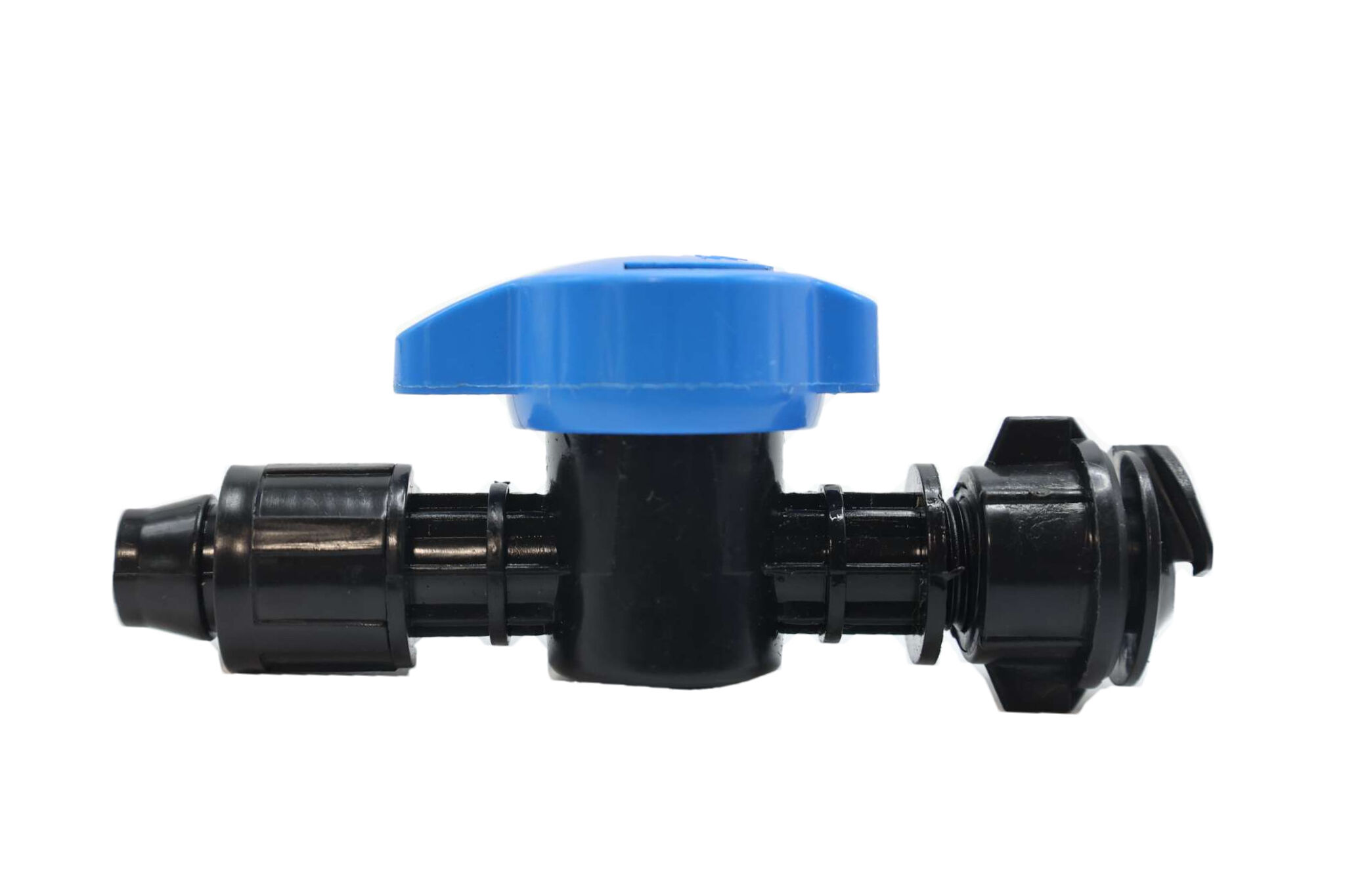Understanding the Mini Bypass Valve and Its Role in Irrigation Systems
What is a Mini Bypass Valve and How It Differs from Other Irrigation Valve Types
The mini bypass valve serves as a small but important mechanical tool for handling those annoying pressure changes in micro irrigation setups. While regular solenoid valves need electricity to open and close, these little guys work passively, sending extra water right back into the main line whenever there's a sudden pressure jump. Because they take up so little room, farmers and gardeners can easily install them alongside drip tapes and along lateral lines without worrying about finding enough space for bigger options like traditional pressure relief valves which just don't fit in tight spots.
The Function of Mini Bypass Valves in Drip Irrigation System Components
Mini Bypass Valves play a critical role in drip irrigation systems acting kind of like shock absorbers for the hydraulic system. These valves protect delicate emitters from getting damaged when there are sudden spikes in pressure. When pressure goes above about 20 to 30 PSI something that often happens when pumps start up or valves get closed quickly the valves open up a small bypass path to let out some of that extra pressure. This keeps things running smoothly at the right pressure levels, which makes drip irrigation work better. Drip systems with proper pressure management can actually cut down water use by around 30 to 50 percent compared to traditional flood methods according to research from Global AgTech Initiative back in 2024. Farmers who install these valves report fewer problems with emitters blowing out and much more consistent water distribution across their fields, which means their entire irrigation setup lasts longer without needing constant repairs.
Comparison with In-Line vs Anti-Siphon Valves for Residential Irrigation
While in-line valves manage zone-based water delivery and anti-siphon valves prevent backflow contamination, Mini Bypass Valves uniquely ensure hydraulic stability. A well-designed residential system often integrates all three:
- In-line valves: Control water flow to specific zones
- Anti-siphon valves: Installed above ground to protect potable water supplies
- Mini Bypass Valves: Positioned near pressure-sensitive components like drip tape connectors
This layered approach minimizes the risk of system failure due to improper pressure management, which can increase maintenance costs by up to 40%. Rather than competing with other valve types, the Mini Bypass Valve complements them by addressing dynamic pressure challenges.
Essential Materials and Tools for Mini Bypass Valve Installation
List of tools and materials: pipes, connectors, and valve housing
Installing a Mini Bypass Valve requires basic tools and compatible components:
- Pipe cutter or hacksaw for clean cuts on PVC or polyethylene tubing
- Adjustable wrenches for securing fittings
- Teflon tape for threaded connections
- Valve housing matching your line size (typically ½” or ¾”)
- Pressure-rated, UV-stabilized pipes and tubing for outdoor durability
Selecting compatible components from Jinan Hongshengyuan Water Saving Irrigation Co Ltd
When selecting equipment, go with standard kits from trusted companies such as Jinan Hongshengyuan Water Saving Irrigation Co Ltd. These folks actually test their products under real pressure conditions and check how they handle different flow rates. The Mini Bypass Valves work really well with existing drip irrigation systems without causing headaches later on when threads don't match up or materials start breaking down over time. For those concerned about durability, make sure to find components where the housing and O rings have passed ISO 9001 certification tests for resisting chemicals and standing up against harsh environments.
Importance of pressure regulators and backflow preventers in valve setup
To get the most out of Mini Bypass Valves, it makes sense to connect them with pressure regulators covering the 15 to 50 PSI range along with proper backflow preventers. The regulators help absorb those sudden pressure surges before they can damage the bypass components. Backflow prevention is another must have feature since it stops contaminants from flowing backward into the system, which matters a lot for chemigation applications where water quality counts. When someone installs a 30 PSI regulator together with a dual check valve setup, studies indicate around a 34% drop in problems with lateral lines across multiple zones. This combination tends to keep irrigation systems running smoothly over time instead of breaking down unexpectedly.
Common System Issues Without a Mini Bypass Valve and How It Prevents Damage
When an irrigation system doesn't have a Mini Bypass Valve installed, there are real problems waiting to happen. Water hammer effects, lots of leaks developing over time, and parts breaking down sooner than they should all become major headaches. What happens when valves close suddenly or pumps shut off? Pressure spikes can shoot up past 150 PSI in those lines without proper regulation, which puts serious stress on pipe connections and actually makes the walls of the pipes weaker over time. The USDA has looked into this stuff too, and their research shows these pressure surges make leaks much more likely to form down the road something like 27% more often than in properly regulated systems.
A 2022 case study from an Arizona farm found drip tape failure rates tripled in systems lacking bypass protection due to pressure imbalances between mainlines and laterals. The Mini Bypass Valve prevents this by using a pressure-sensitive diaphragm to instantly divert excess flow, maintaining safe operating pressures of 15–30 PSI.
Key benefits include:
- Dissipates 92% of water hammer energy through immediate pressure relief
- Reduces lateral line stress fractures by 40% (USDA, 2022)
- Eliminates need for manual adjustments during system startup
Systems equipped with bypass valves experience 63% fewer emergency repairs over five years, underscoring their role as essential safeguards in modern irrigation design.
Step-by-Step Installation Process for the Mini Bypass Valve
Shutting off water supply and depressurizing the irrigation line
Begin by closing the main shutoff valve to isolate the system. Release residual pressure by opening a downstream outlet or using a pressure release tool. This step is crucial to avoid accidental surges that could damage pipes or emitters during installation.
Cutting the pipe and preparing the connection point for the Mini Bypass Valve
Mark the installation site 12–18 inches upstream of lateral lines. Use sharp tubing cutters to make a square, burr-free cut. Deburr the inside and outside edges, then wipe the pipe clean to ensure a proper seal and smooth fitting insertion.
Installing the valve using compression or barbed fittings
For 1" polyethylene lines, compression fittings offer reliable, tool-free connections. For flexible drip tubing, use barbed fittings secured with stainless-steel clamps. Always align the valve’s flow arrow with the direction of water movement to prevent reverse flow and ensure proper operation.
Ensuring leak prevention during valve installation with proper sealing
Follow best practices for leak-free joints:
- Wrap Teflon tape clockwise around male threads (2–3 layers)
- Apply silicone grease to compression gaskets to prevent drying and cracking
- Tighten fittings until snug, then give a final ¼-turn with channel locks—avoid over-tightening
Reconnecting and testing the system under low pressure
Gradually reintroduce water at 15 PSI—about half the normal operating pressure. Inspect all connections for leaks while manually cycling the system. Test automatic relief by temporarily blocking downstream flow; the valve should activate within seconds to release excess pressure.
Maintenance, Advancements, and Future-Proofing Your Mini Bypass Valve System
Regular maintenance extends the service life of a Mini Bypass Valve to 5–7 years. Conduct monthly inspections: check for mineral buildup, verify diaphragm responsiveness, and clear pilot channels with compressed air. The 2023 irrigation maintenance framework recommends tracking flow rates before and after cleaning to assess performance changes over time.
Winterization Tips to Prevent Freeze-Related Valve Damage
In freezing climates, insulate valve bodies with closed-cell foam sleeves and drain lateral lines below frost level. Blow out bypass ports with compressed air until no moisture remains—this prevents ice expansion from cracking internal components.
Emergence of Self-Regulating Mini Bypass Valves in Modern Drip Systems
Next-generation models feature self-adjusting orifices that respond to pressure changes within ±15 PSI. These intelligent valves integrate with soil moisture sensors, reducing the need for manual calibration by up to 60% compared to fixed mechanical designs.
Compatibility With Automated Controllers and Moisture Sensors
Third-generation Mini Bypass Valves support Modbus RTU protocols, enabling seamless integration with over 95% of smart irrigation controllers. When upgrading older systems, confirm the model has 1/4” NPT threads for direct sensor attachment.
Industry Paradox: Cost vs. Longevity in Small-Scale Irrigation Upgrades
Although stainless-steel valves cost three times more than PVC versions, USDA data shows they reduce leak incidents by 40% (2022 Irrigation Efficiency Report). Over a decade, metal valves require 50% fewer replacements, translating to significant labor and downtime savings—making them a cost-effective choice for long-term system resilience.
FAQs
What is a Mini Bypass Valve and how does it function in irrigation systems?
A Mini Bypass Valve helps manage pressure fluctuations in micro irrigation systems by diverting excess water to maintain stable pressures, protecting delicate components from damage.
How do Mini Bypass Valves differ from other types such as in-line and anti-siphon valves?
While in-line valves control water flow to specific zones and anti-siphon valves prevent water contamination, Mini Bypass Valves provide hydraulic stability by addressing dynamic pressure changes.
Why is pressure regulation important in drip irrigation systems?
Proper pressure regulation prevents damage and ensures efficient water distribution, significantly reducing water waste and maintenance issues.
What tools and materials are needed for Mini Bypass Valve installation?
You need pipe cutters or hacksaws, adjustable wrenches, Teflon tape, and pressure-rated pipes. Proper valve housing and compatible fittings are also required.
How often should maintenance be performed on a Mini Bypass Valve?
Maintenance should be conducted monthly to ensure longevity, including inspections for mineral buildup and diaphragm responsiveness.
Table of Contents
- Understanding the Mini Bypass Valve and Its Role in Irrigation Systems
- Essential Materials and Tools for Mini Bypass Valve Installation
- Common System Issues Without a Mini Bypass Valve and How It Prevents Damage
-
Step-by-Step Installation Process for the Mini Bypass Valve
- Shutting off water supply and depressurizing the irrigation line
- Cutting the pipe and preparing the connection point for the Mini Bypass Valve
- Installing the valve using compression or barbed fittings
- Ensuring leak prevention during valve installation with proper sealing
- Reconnecting and testing the system under low pressure
- Maintenance, Advancements, and Future-Proofing Your Mini Bypass Valve System
-
FAQs
- What is a Mini Bypass Valve and how does it function in irrigation systems?
- How do Mini Bypass Valves differ from other types such as in-line and anti-siphon valves?
- Why is pressure regulation important in drip irrigation systems?
- What tools and materials are needed for Mini Bypass Valve installation?
- How often should maintenance be performed on a Mini Bypass Valve?

